Health and Social Care: Professional Relationships Report
VerifiedAdded on 2022/12/16
|15
|2253
|36
Report
AI Summary
This report delves into the core aspects of health and social care, focusing on collaborative working practices, professional relationships, and conflict management strategies. It begins with an introduction to the Care Act 2014 and its objectives, along with definitions of professional and care standards. The main body explores theories of communication, motivation, and teamwork, highlighting their role in developing professional relationships. It then examines conflict management techniques, including approaches to resolving disputes and improving service quality. The report further investigates the significance of collaborative working, outlining its aims, benefits, and barriers within the health and social care sector. Finally, it critically evaluates the importance of professional relationships in enhancing care standards, providing reasons for successes and challenges. The report concludes by summarizing key findings and offering relevant references.
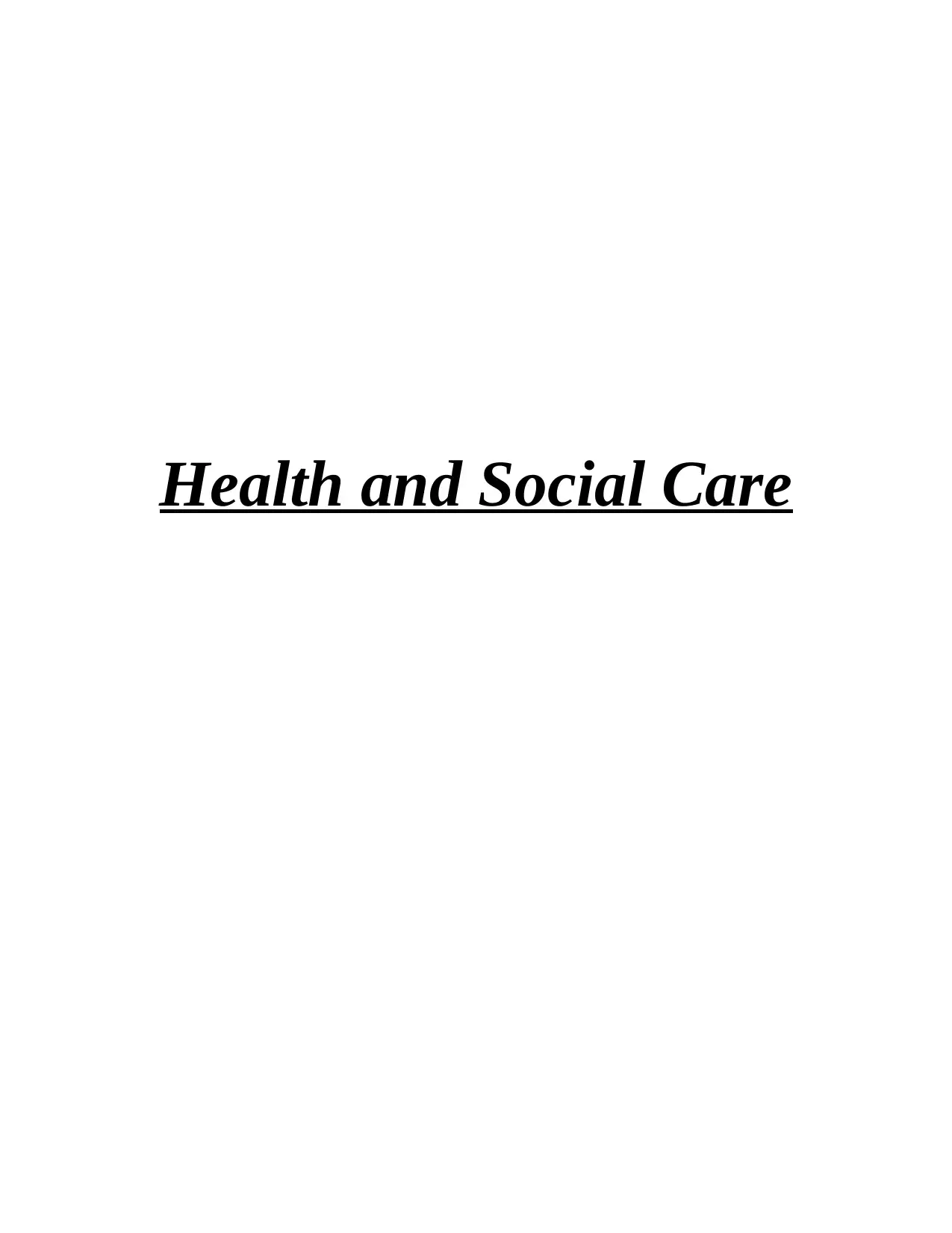
Health and Social Care
Paraphrase This Document
Need a fresh take? Get an instant paraphrase of this document with our AI Paraphraser
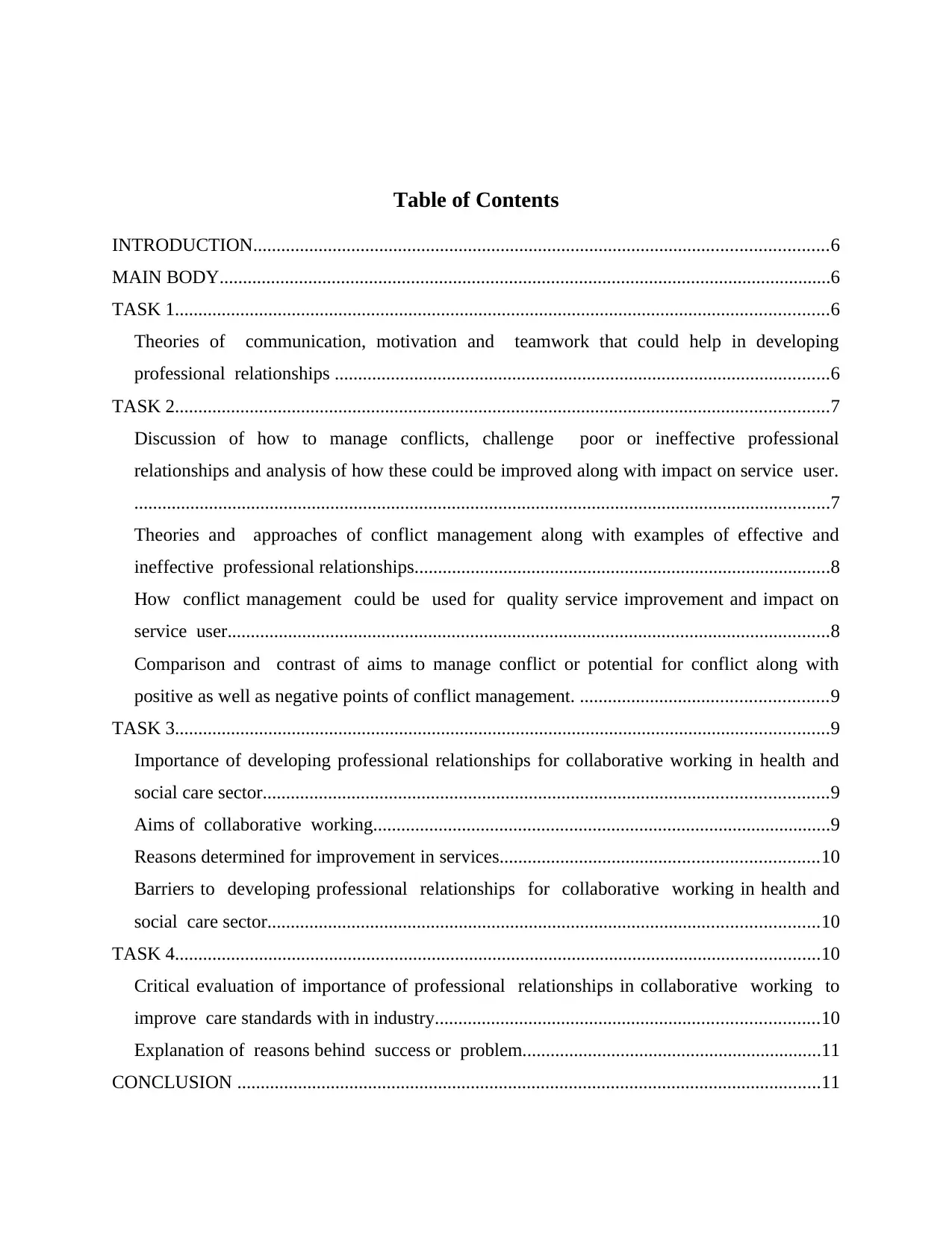
Table of Contents
INTRODUCTION...........................................................................................................................6
MAIN BODY...................................................................................................................................6
TASK 1............................................................................................................................................6
Theories of communication, motivation and teamwork that could help in developing
professional relationships ..........................................................................................................6
TASK 2............................................................................................................................................7
Discussion of how to manage conflicts, challenge poor or ineffective professional
relationships and analysis of how these could be improved along with impact on service user.
.....................................................................................................................................................7
Theories and approaches of conflict management along with examples of effective and
ineffective professional relationships.........................................................................................8
How conflict management could be used for quality service improvement and impact on
service user.................................................................................................................................8
Comparison and contrast of aims to manage conflict or potential for conflict along with
positive as well as negative points of conflict management. .....................................................9
TASK 3............................................................................................................................................9
Importance of developing professional relationships for collaborative working in health and
social care sector.........................................................................................................................9
Aims of collaborative working..................................................................................................9
Reasons determined for improvement in services....................................................................10
Barriers to developing professional relationships for collaborative working in health and
social care sector......................................................................................................................10
TASK 4..........................................................................................................................................10
Critical evaluation of importance of professional relationships in collaborative working to
improve care standards with in industry..................................................................................10
Explanation of reasons behind success or problem................................................................11
CONCLUSION .............................................................................................................................11
INTRODUCTION...........................................................................................................................6
MAIN BODY...................................................................................................................................6
TASK 1............................................................................................................................................6
Theories of communication, motivation and teamwork that could help in developing
professional relationships ..........................................................................................................6
TASK 2............................................................................................................................................7
Discussion of how to manage conflicts, challenge poor or ineffective professional
relationships and analysis of how these could be improved along with impact on service user.
.....................................................................................................................................................7
Theories and approaches of conflict management along with examples of effective and
ineffective professional relationships.........................................................................................8
How conflict management could be used for quality service improvement and impact on
service user.................................................................................................................................8
Comparison and contrast of aims to manage conflict or potential for conflict along with
positive as well as negative points of conflict management. .....................................................9
TASK 3............................................................................................................................................9
Importance of developing professional relationships for collaborative working in health and
social care sector.........................................................................................................................9
Aims of collaborative working..................................................................................................9
Reasons determined for improvement in services....................................................................10
Barriers to developing professional relationships for collaborative working in health and
social care sector......................................................................................................................10
TASK 4..........................................................................................................................................10
Critical evaluation of importance of professional relationships in collaborative working to
improve care standards with in industry..................................................................................10
Explanation of reasons behind success or problem................................................................11
CONCLUSION .............................................................................................................................11

REFERENCES..............................................................................................................................12
⊘ This is a preview!⊘
Do you want full access?
Subscribe today to unlock all pages.

Trusted by 1+ million students worldwide
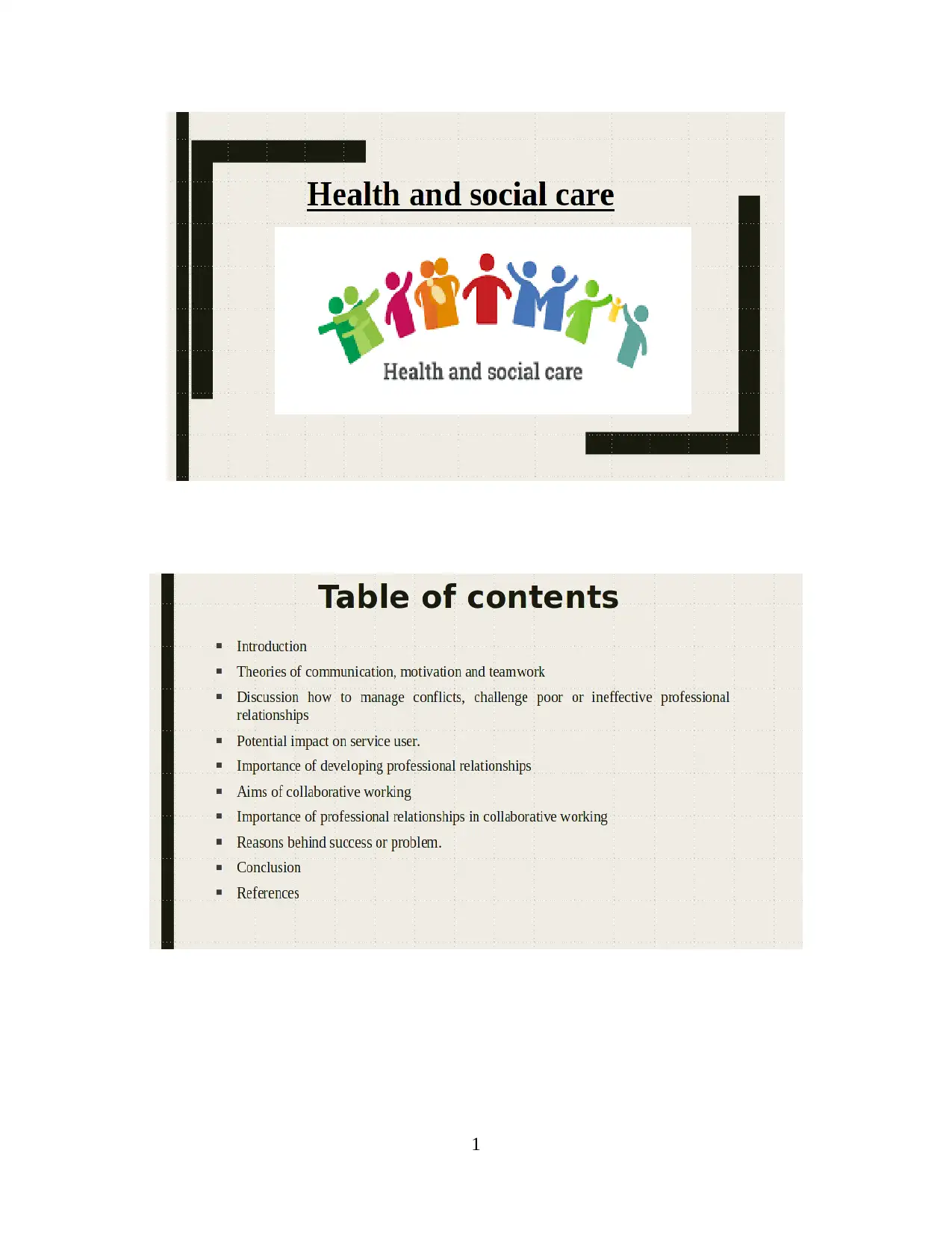
1
Paraphrase This Document
Need a fresh take? Get an instant paraphrase of this document with our AI Paraphraser
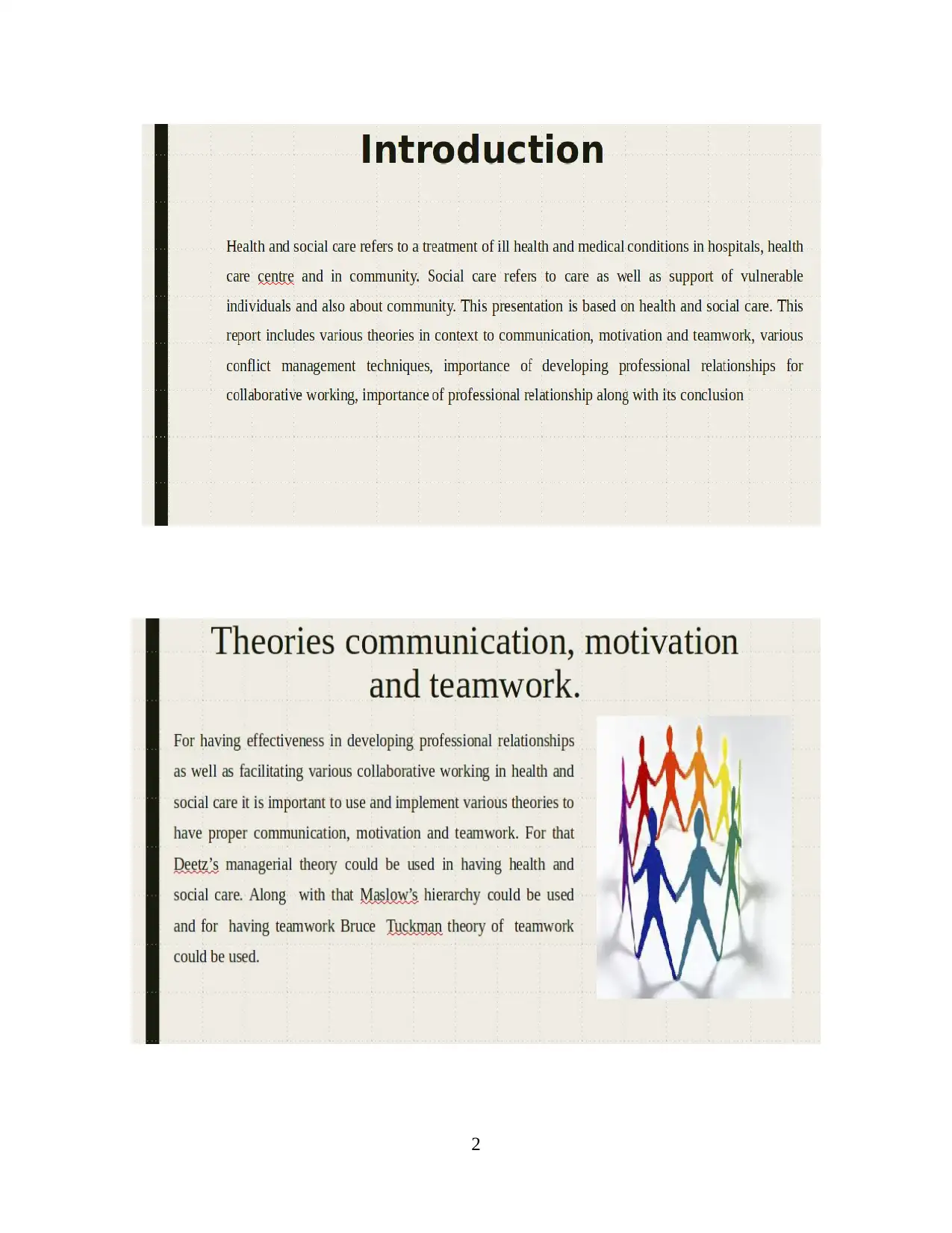
2
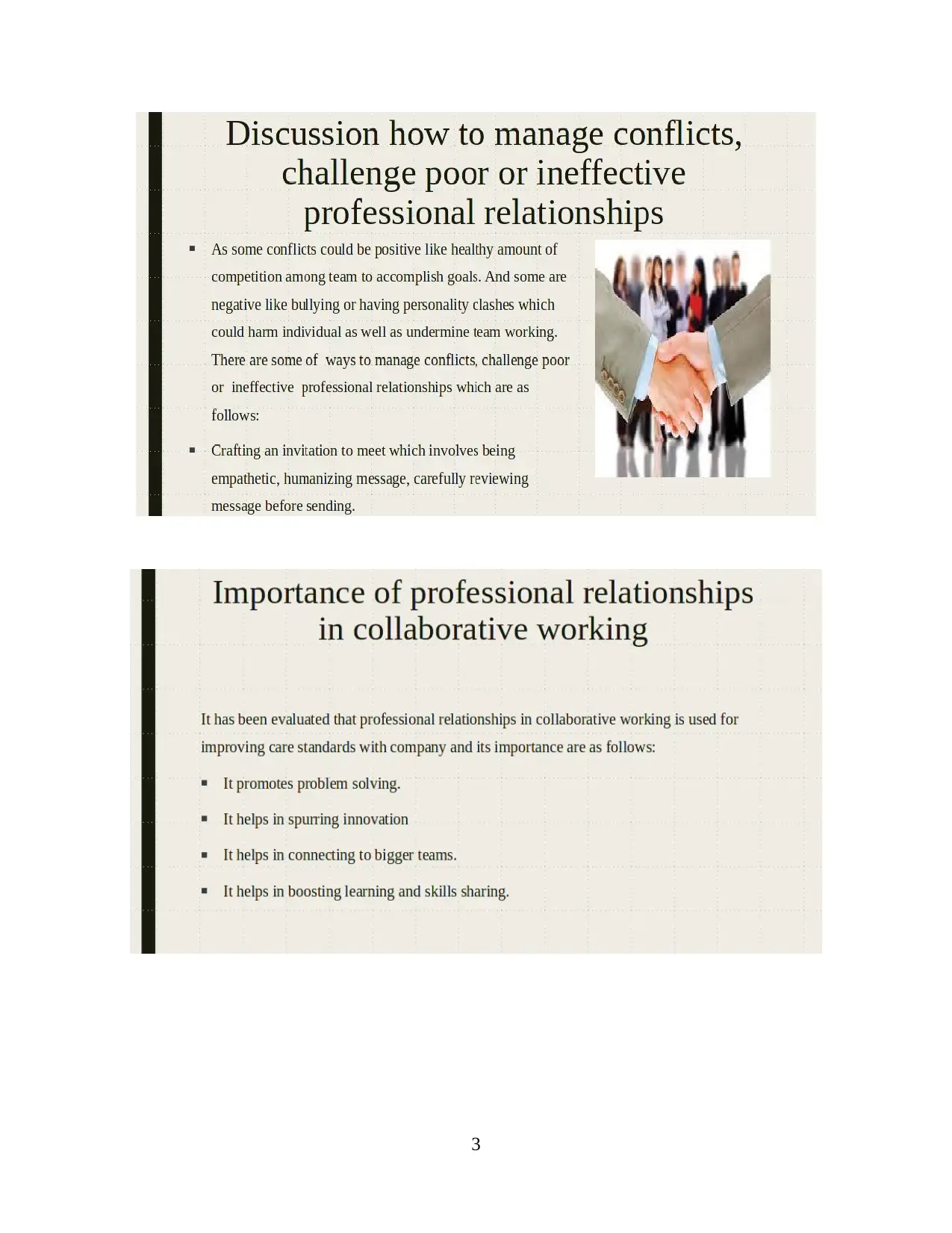
3
⊘ This is a preview!⊘
Do you want full access?
Subscribe today to unlock all pages.

Trusted by 1+ million students worldwide
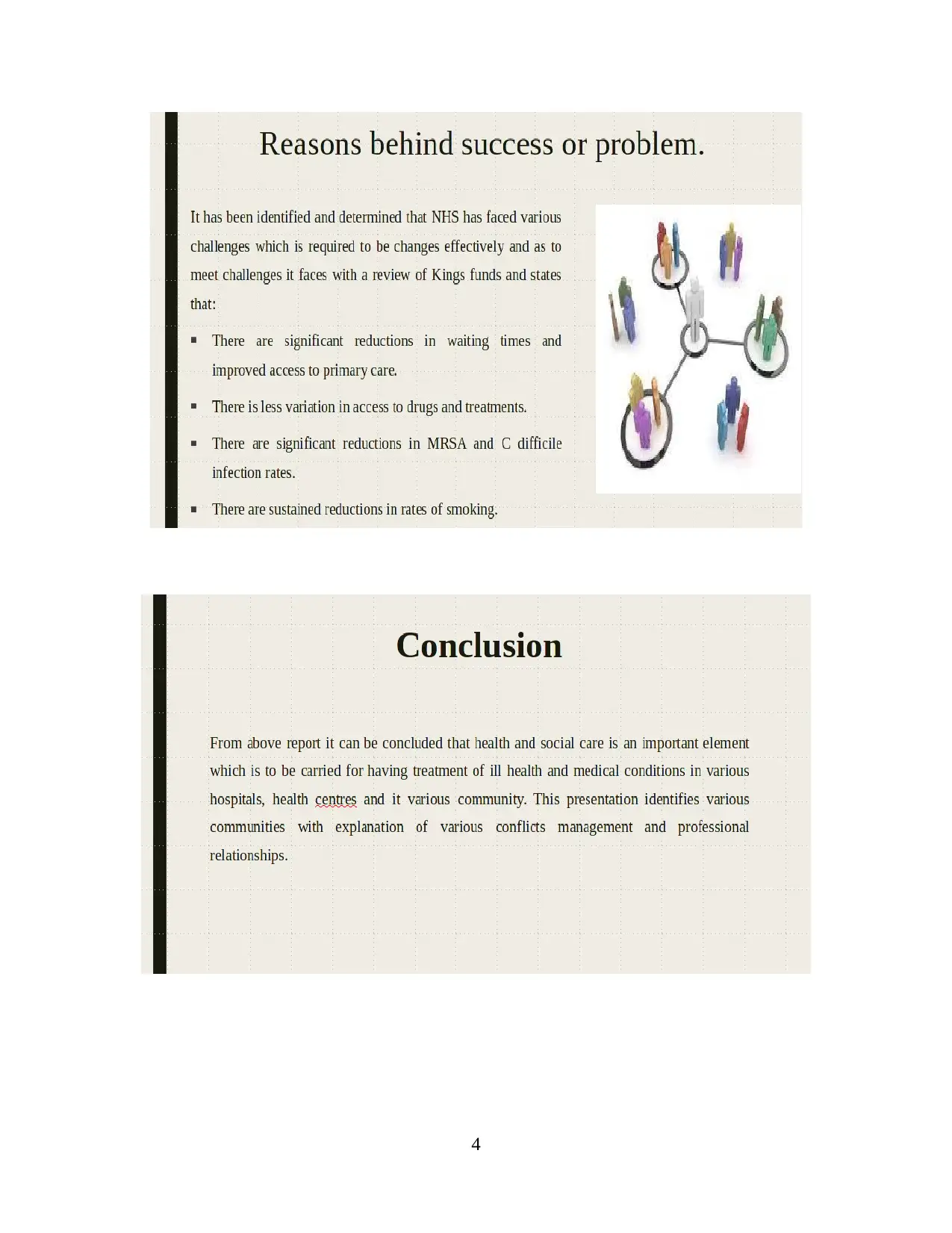
4
Paraphrase This Document
Need a fresh take? Get an instant paraphrase of this document with our AI Paraphraser
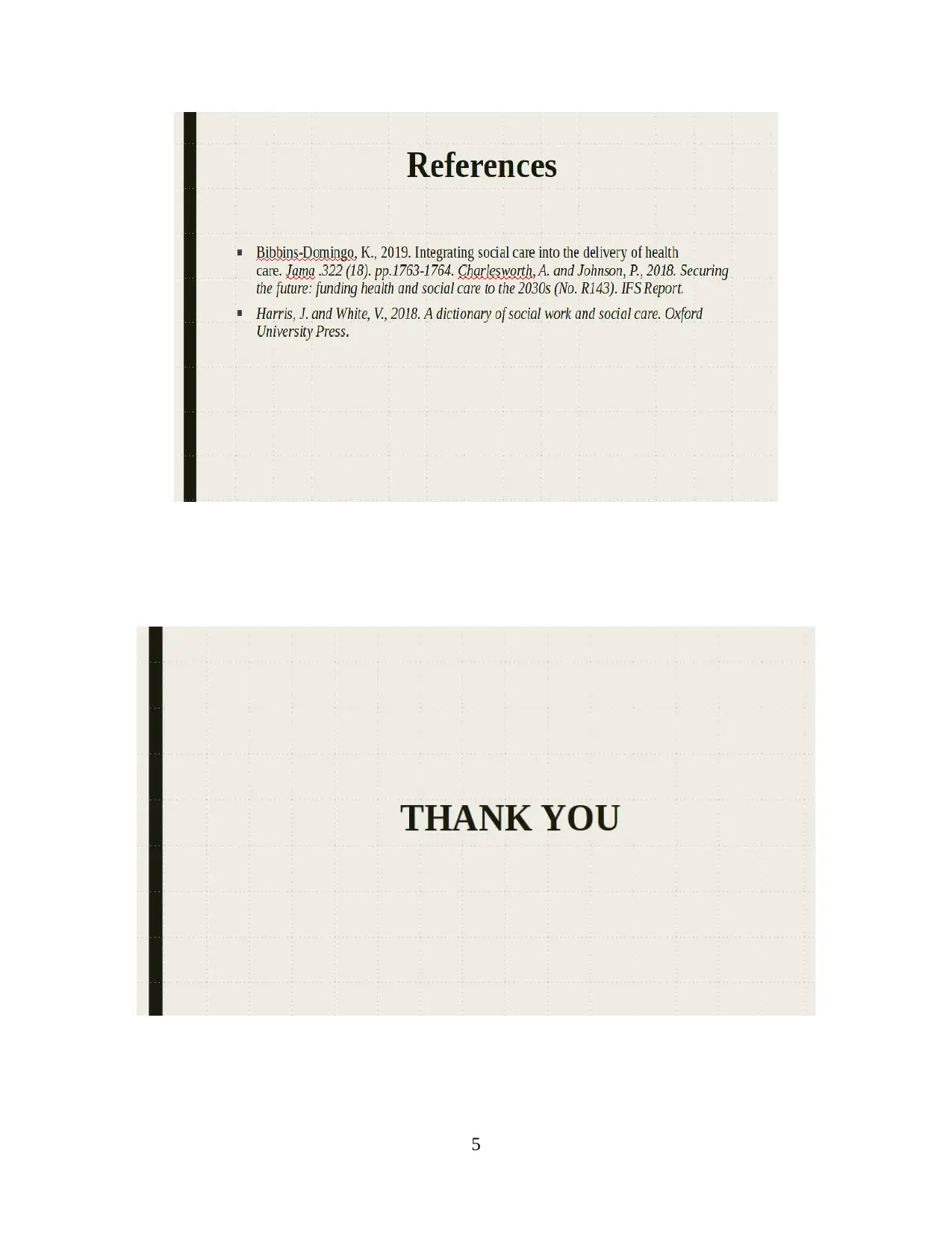
5
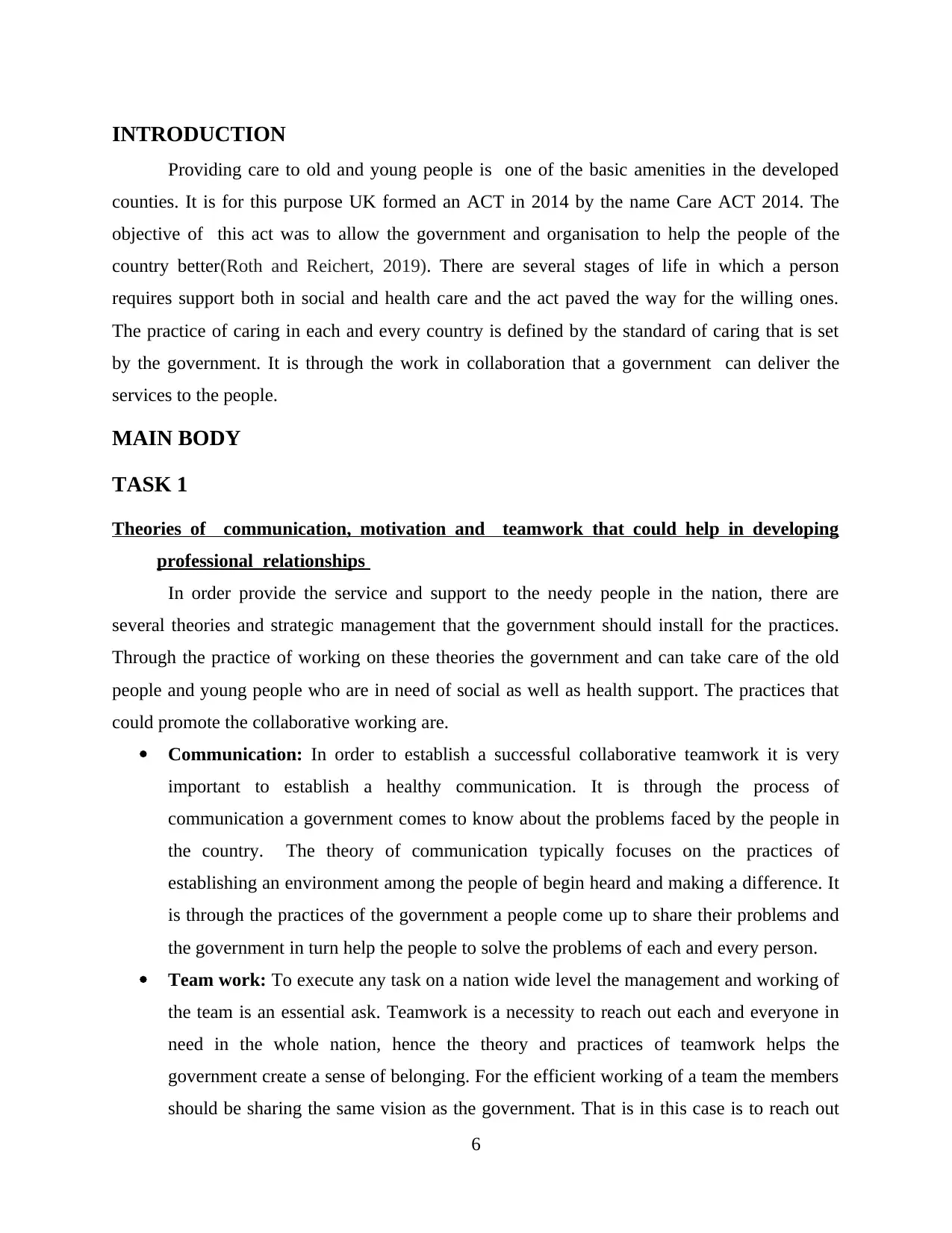
INTRODUCTION
Providing care to old and young people is one of the basic amenities in the developed
counties. It is for this purpose UK formed an ACT in 2014 by the name Care ACT 2014. The
objective of this act was to allow the government and organisation to help the people of the
country better(Roth and Reichert, 2019). There are several stages of life in which a person
requires support both in social and health care and the act paved the way for the willing ones.
The practice of caring in each and every country is defined by the standard of caring that is set
by the government. It is through the work in collaboration that a government can deliver the
services to the people.
MAIN BODY
TASK 1
Theories of communication, motivation and teamwork that could help in developing
professional relationships
In order provide the service and support to the needy people in the nation, there are
several theories and strategic management that the government should install for the practices.
Through the practice of working on these theories the government and can take care of the old
people and young people who are in need of social as well as health support. The practices that
could promote the collaborative working are.
Communication: In order to establish a successful collaborative teamwork it is very
important to establish a healthy communication. It is through the process of
communication a government comes to know about the problems faced by the people in
the country. The theory of communication typically focuses on the practices of
establishing an environment among the people of begin heard and making a difference. It
is through the practices of the government a people come up to share their problems and
the government in turn help the people to solve the problems of each and every person.
Team work: To execute any task on a nation wide level the management and working of
the team is an essential ask. Teamwork is a necessity to reach out each and everyone in
need in the whole nation, hence the theory and practices of teamwork helps the
government create a sense of belonging. For the efficient working of a team the members
should be sharing the same vision as the government. That is in this case is to reach out
6
Providing care to old and young people is one of the basic amenities in the developed
counties. It is for this purpose UK formed an ACT in 2014 by the name Care ACT 2014. The
objective of this act was to allow the government and organisation to help the people of the
country better(Roth and Reichert, 2019). There are several stages of life in which a person
requires support both in social and health care and the act paved the way for the willing ones.
The practice of caring in each and every country is defined by the standard of caring that is set
by the government. It is through the work in collaboration that a government can deliver the
services to the people.
MAIN BODY
TASK 1
Theories of communication, motivation and teamwork that could help in developing
professional relationships
In order provide the service and support to the needy people in the nation, there are
several theories and strategic management that the government should install for the practices.
Through the practice of working on these theories the government and can take care of the old
people and young people who are in need of social as well as health support. The practices that
could promote the collaborative working are.
Communication: In order to establish a successful collaborative teamwork it is very
important to establish a healthy communication. It is through the process of
communication a government comes to know about the problems faced by the people in
the country. The theory of communication typically focuses on the practices of
establishing an environment among the people of begin heard and making a difference. It
is through the practices of the government a people come up to share their problems and
the government in turn help the people to solve the problems of each and every person.
Team work: To execute any task on a nation wide level the management and working of
the team is an essential ask. Teamwork is a necessity to reach out each and everyone in
need in the whole nation, hence the theory and practices of teamwork helps the
government create a sense of belonging. For the efficient working of a team the members
should be sharing the same vision as the government. That is in this case is to reach out
6
⊘ This is a preview!⊘
Do you want full access?
Subscribe today to unlock all pages.

Trusted by 1+ million students worldwide
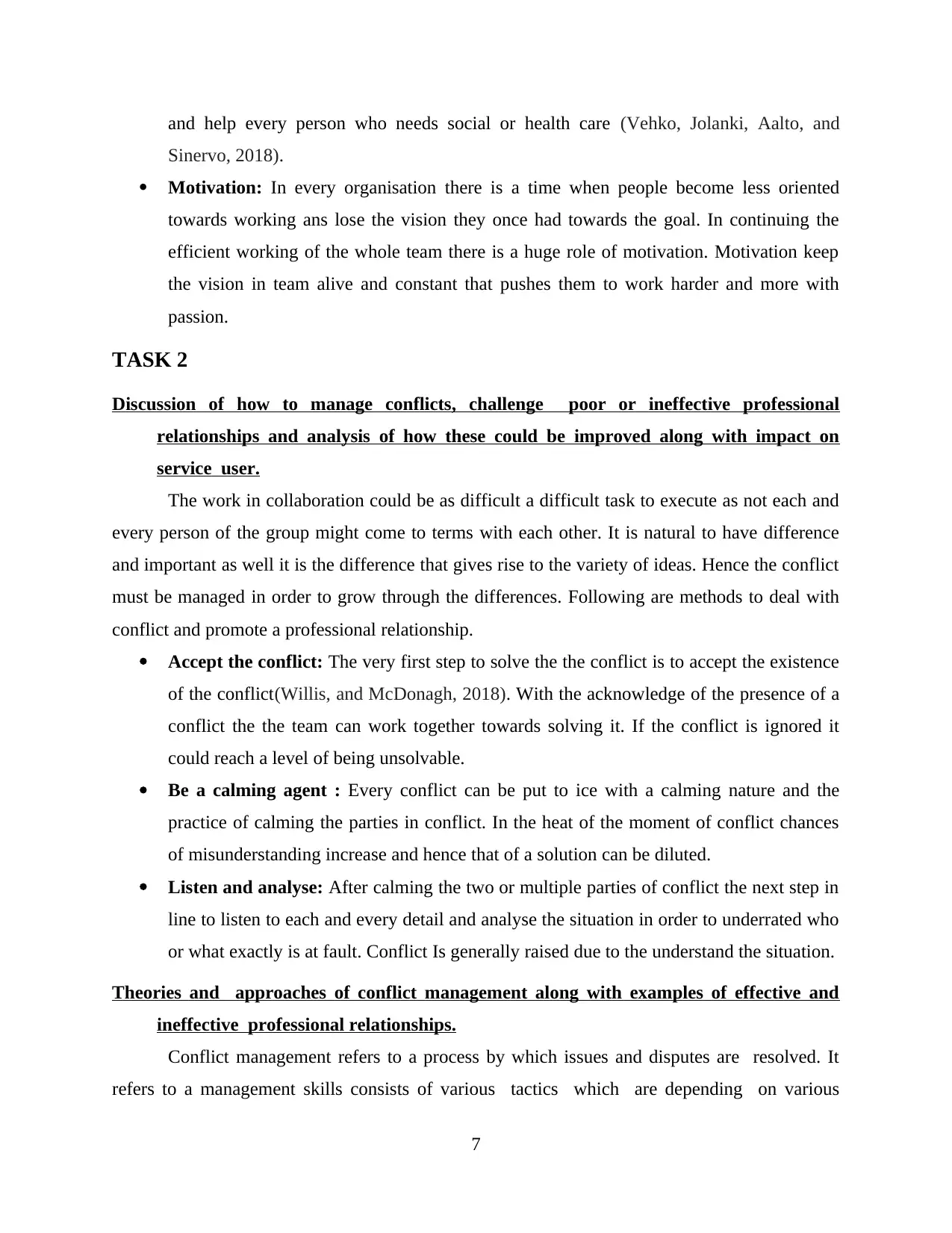
and help every person who needs social or health care (Vehko, Jolanki, Aalto, and
Sinervo, 2018).
Motivation: In every organisation there is a time when people become less oriented
towards working ans lose the vision they once had towards the goal. In continuing the
efficient working of the whole team there is a huge role of motivation. Motivation keep
the vision in team alive and constant that pushes them to work harder and more with
passion.
TASK 2
Discussion of how to manage conflicts, challenge poor or ineffective professional
relationships and analysis of how these could be improved along with impact on
service user.
The work in collaboration could be as difficult a difficult task to execute as not each and
every person of the group might come to terms with each other. It is natural to have difference
and important as well it is the difference that gives rise to the variety of ideas. Hence the conflict
must be managed in order to grow through the differences. Following are methods to deal with
conflict and promote a professional relationship.
Accept the conflict: The very first step to solve the the conflict is to accept the existence
of the conflict(Willis, and McDonagh, 2018). With the acknowledge of the presence of a
conflict the the team can work together towards solving it. If the conflict is ignored it
could reach a level of being unsolvable.
Be a calming agent : Every conflict can be put to ice with a calming nature and the
practice of calming the parties in conflict. In the heat of the moment of conflict chances
of misunderstanding increase and hence that of a solution can be diluted.
Listen and analyse: After calming the two or multiple parties of conflict the next step in
line to listen to each and every detail and analyse the situation in order to underrated who
or what exactly is at fault. Conflict Is generally raised due to the understand the situation.
Theories and approaches of conflict management along with examples of effective and
ineffective professional relationships.
Conflict management refers to a process by which issues and disputes are resolved. It
refers to a management skills consists of various tactics which are depending on various
7
Sinervo, 2018).
Motivation: In every organisation there is a time when people become less oriented
towards working ans lose the vision they once had towards the goal. In continuing the
efficient working of the whole team there is a huge role of motivation. Motivation keep
the vision in team alive and constant that pushes them to work harder and more with
passion.
TASK 2
Discussion of how to manage conflicts, challenge poor or ineffective professional
relationships and analysis of how these could be improved along with impact on
service user.
The work in collaboration could be as difficult a difficult task to execute as not each and
every person of the group might come to terms with each other. It is natural to have difference
and important as well it is the difference that gives rise to the variety of ideas. Hence the conflict
must be managed in order to grow through the differences. Following are methods to deal with
conflict and promote a professional relationship.
Accept the conflict: The very first step to solve the the conflict is to accept the existence
of the conflict(Willis, and McDonagh, 2018). With the acknowledge of the presence of a
conflict the the team can work together towards solving it. If the conflict is ignored it
could reach a level of being unsolvable.
Be a calming agent : Every conflict can be put to ice with a calming nature and the
practice of calming the parties in conflict. In the heat of the moment of conflict chances
of misunderstanding increase and hence that of a solution can be diluted.
Listen and analyse: After calming the two or multiple parties of conflict the next step in
line to listen to each and every detail and analyse the situation in order to underrated who
or what exactly is at fault. Conflict Is generally raised due to the understand the situation.
Theories and approaches of conflict management along with examples of effective and
ineffective professional relationships.
Conflict management refers to a process by which issues and disputes are resolved. It
refers to a management skills consists of various tactics which are depending on various
7
Paraphrase This Document
Need a fresh take? Get an instant paraphrase of this document with our AI Paraphraser
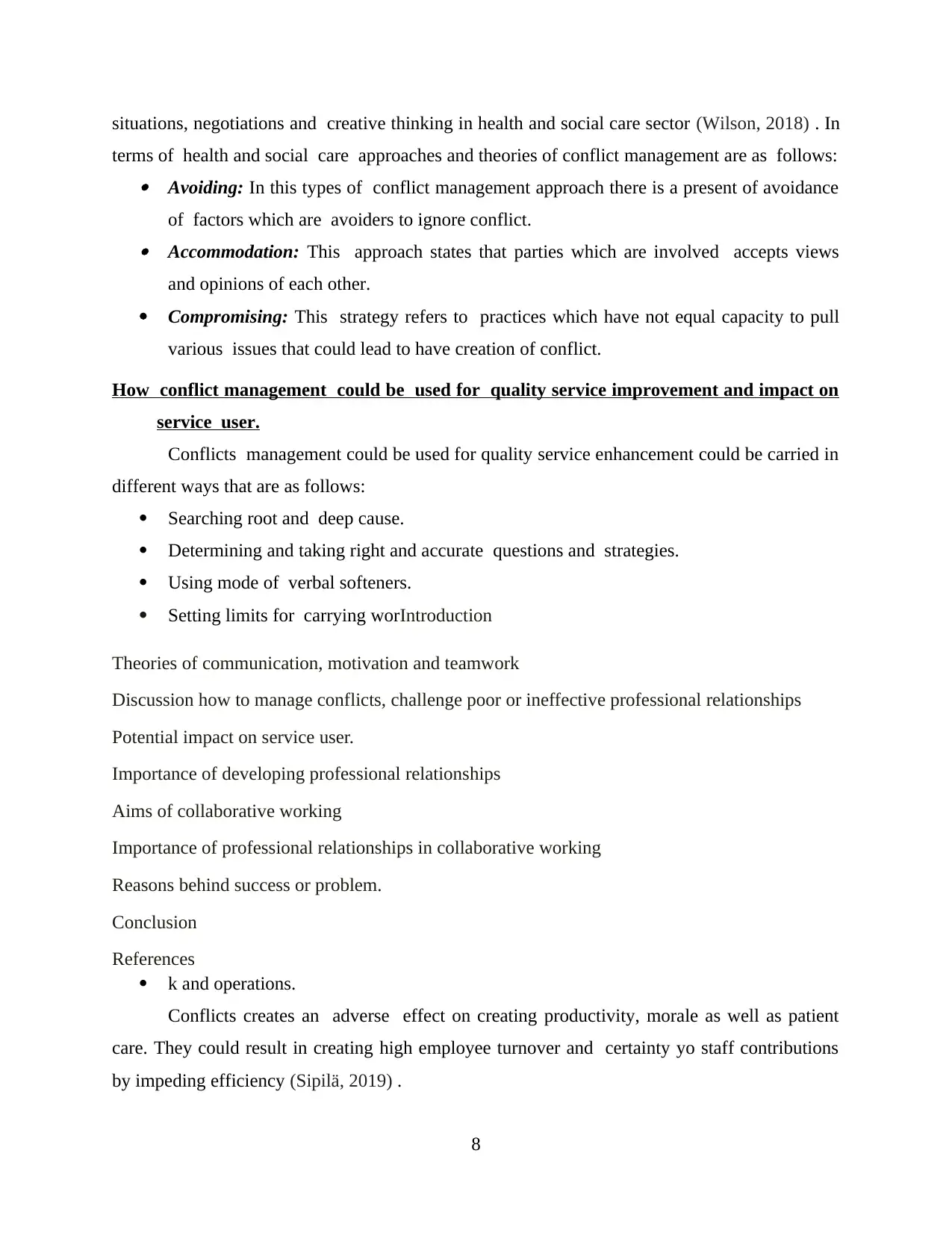
situations, negotiations and creative thinking in health and social care sector (Wilson, 2018) . In
terms of health and social care approaches and theories of conflict management are as follows: Avoiding: In this types of conflict management approach there is a present of avoidance
of factors which are avoiders to ignore conflict. Accommodation: This approach states that parties which are involved accepts views
and opinions of each other.
Compromising: This strategy refers to practices which have not equal capacity to pull
various issues that could lead to have creation of conflict.
How conflict management could be used for quality service improvement and impact on
service user.
Conflicts management could be used for quality service enhancement could be carried in
different ways that are as follows:
Searching root and deep cause.
Determining and taking right and accurate questions and strategies.
Using mode of verbal softeners.
Setting limits for carrying worIntroduction
Theories of communication, motivation and teamwork
Discussion how to manage conflicts, challenge poor or ineffective professional relationships
Potential impact on service user.
Importance of developing professional relationships
Aims of collaborative working
Importance of professional relationships in collaborative working
Reasons behind success or problem.
Conclusion
References
k and operations.
Conflicts creates an adverse effect on creating productivity, morale as well as patient
care. They could result in creating high employee turnover and certainty yo staff contributions
by impeding efficiency (Sipilä, 2019) .
8
terms of health and social care approaches and theories of conflict management are as follows: Avoiding: In this types of conflict management approach there is a present of avoidance
of factors which are avoiders to ignore conflict. Accommodation: This approach states that parties which are involved accepts views
and opinions of each other.
Compromising: This strategy refers to practices which have not equal capacity to pull
various issues that could lead to have creation of conflict.
How conflict management could be used for quality service improvement and impact on
service user.
Conflicts management could be used for quality service enhancement could be carried in
different ways that are as follows:
Searching root and deep cause.
Determining and taking right and accurate questions and strategies.
Using mode of verbal softeners.
Setting limits for carrying worIntroduction
Theories of communication, motivation and teamwork
Discussion how to manage conflicts, challenge poor or ineffective professional relationships
Potential impact on service user.
Importance of developing professional relationships
Aims of collaborative working
Importance of professional relationships in collaborative working
Reasons behind success or problem.
Conclusion
References
k and operations.
Conflicts creates an adverse effect on creating productivity, morale as well as patient
care. They could result in creating high employee turnover and certainty yo staff contributions
by impeding efficiency (Sipilä, 2019) .
8
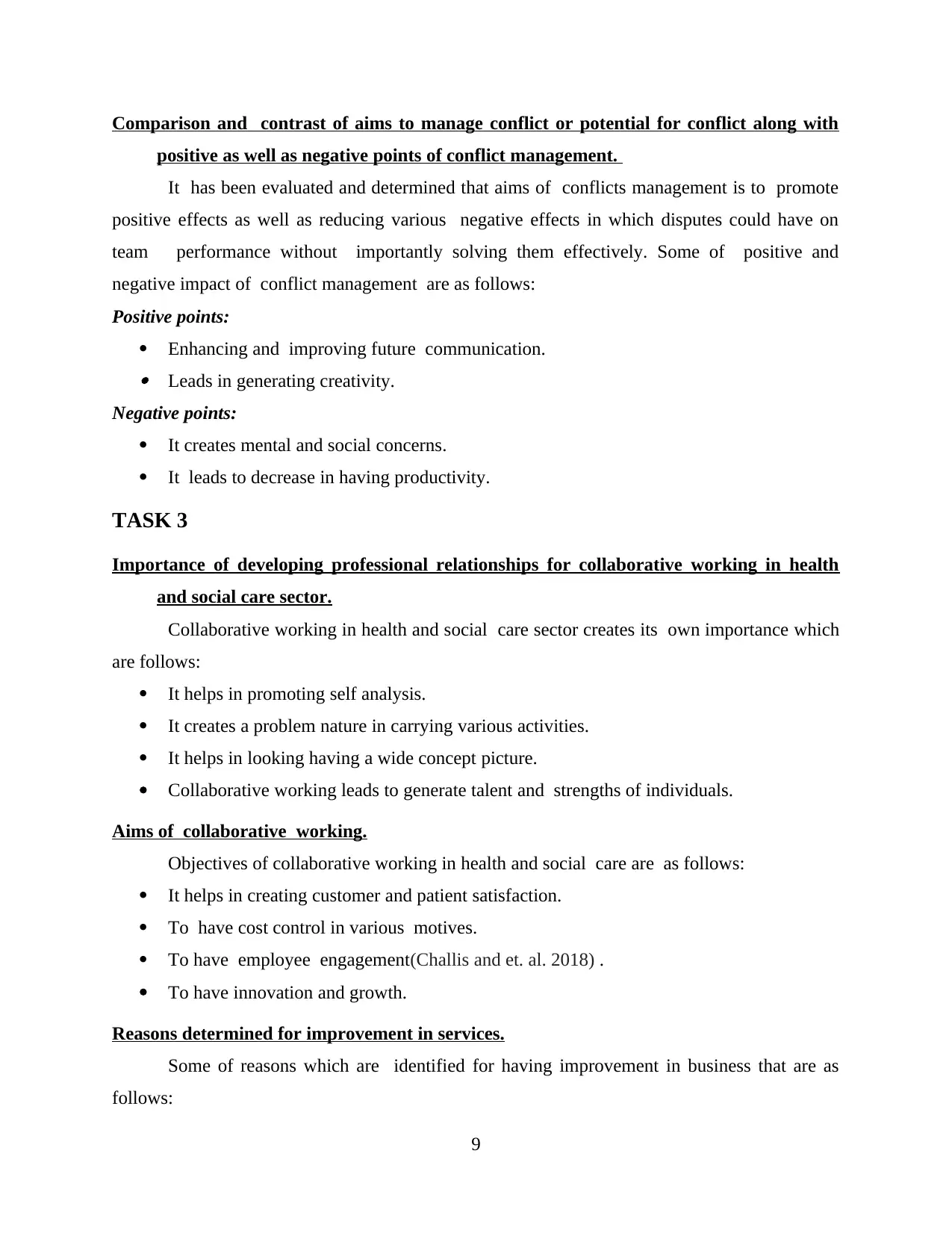
Comparison and contrast of aims to manage conflict or potential for conflict along with
positive as well as negative points of conflict management.
It has been evaluated and determined that aims of conflicts management is to promote
positive effects as well as reducing various negative effects in which disputes could have on
team performance without importantly solving them effectively. Some of positive and
negative impact of conflict management are as follows:
Positive points:
Enhancing and improving future communication. Leads in generating creativity.
Negative points:
It creates mental and social concerns.
It leads to decrease in having productivity.
TASK 3
Importance of developing professional relationships for collaborative working in health
and social care sector.
Collaborative working in health and social care sector creates its own importance which
are follows:
It helps in promoting self analysis.
It creates a problem nature in carrying various activities.
It helps in looking having a wide concept picture.
Collaborative working leads to generate talent and strengths of individuals.
Aims of collaborative working.
Objectives of collaborative working in health and social care are as follows:
It helps in creating customer and patient satisfaction.
To have cost control in various motives.
To have employee engagement(Challis and et. al. 2018) .
To have innovation and growth.
Reasons determined for improvement in services.
Some of reasons which are identified for having improvement in business that are as
follows:
9
positive as well as negative points of conflict management.
It has been evaluated and determined that aims of conflicts management is to promote
positive effects as well as reducing various negative effects in which disputes could have on
team performance without importantly solving them effectively. Some of positive and
negative impact of conflict management are as follows:
Positive points:
Enhancing and improving future communication. Leads in generating creativity.
Negative points:
It creates mental and social concerns.
It leads to decrease in having productivity.
TASK 3
Importance of developing professional relationships for collaborative working in health
and social care sector.
Collaborative working in health and social care sector creates its own importance which
are follows:
It helps in promoting self analysis.
It creates a problem nature in carrying various activities.
It helps in looking having a wide concept picture.
Collaborative working leads to generate talent and strengths of individuals.
Aims of collaborative working.
Objectives of collaborative working in health and social care are as follows:
It helps in creating customer and patient satisfaction.
To have cost control in various motives.
To have employee engagement(Challis and et. al. 2018) .
To have innovation and growth.
Reasons determined for improvement in services.
Some of reasons which are identified for having improvement in business that are as
follows:
9
⊘ This is a preview!⊘
Do you want full access?
Subscribe today to unlock all pages.

Trusted by 1+ million students worldwide
1 out of 15
Related Documents
Your All-in-One AI-Powered Toolkit for Academic Success.
+13062052269
info@desklib.com
Available 24*7 on WhatsApp / Email
![[object Object]](/_next/static/media/star-bottom.7253800d.svg)
Unlock your academic potential
Copyright © 2020–2025 A2Z Services. All Rights Reserved. Developed and managed by ZUCOL.





